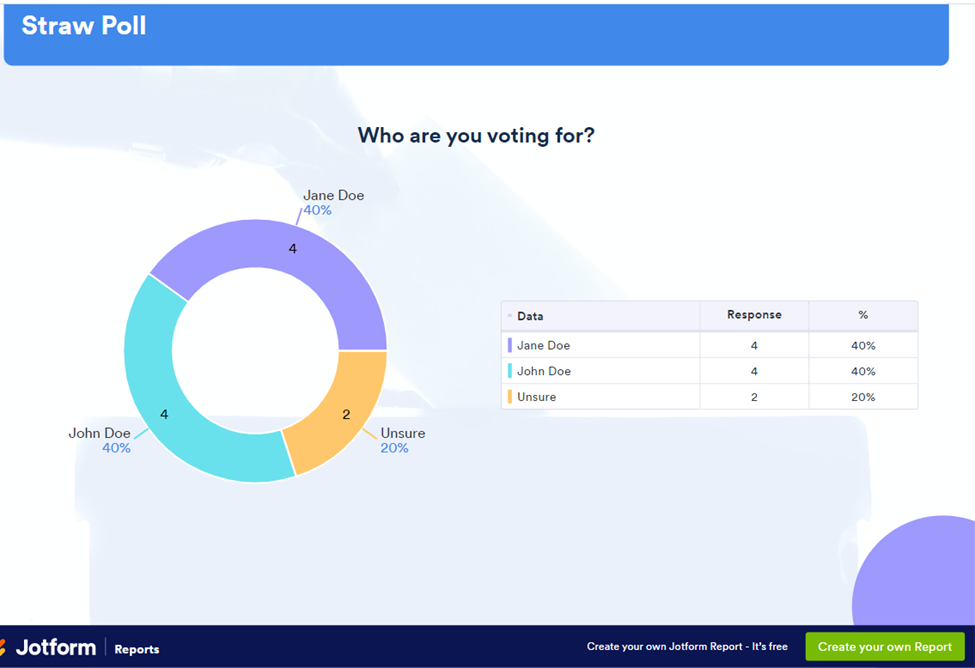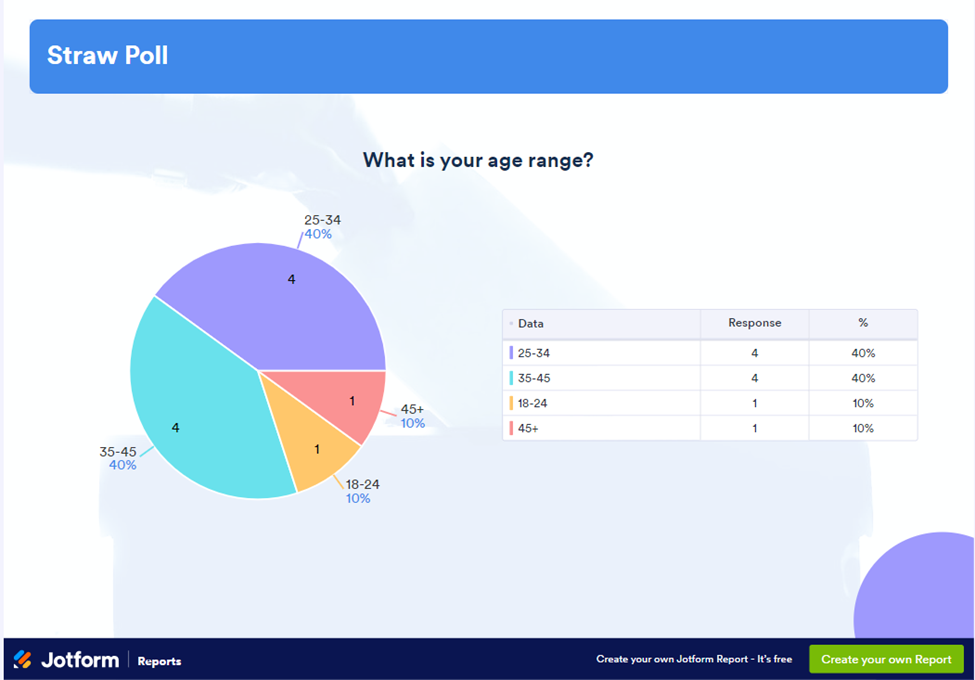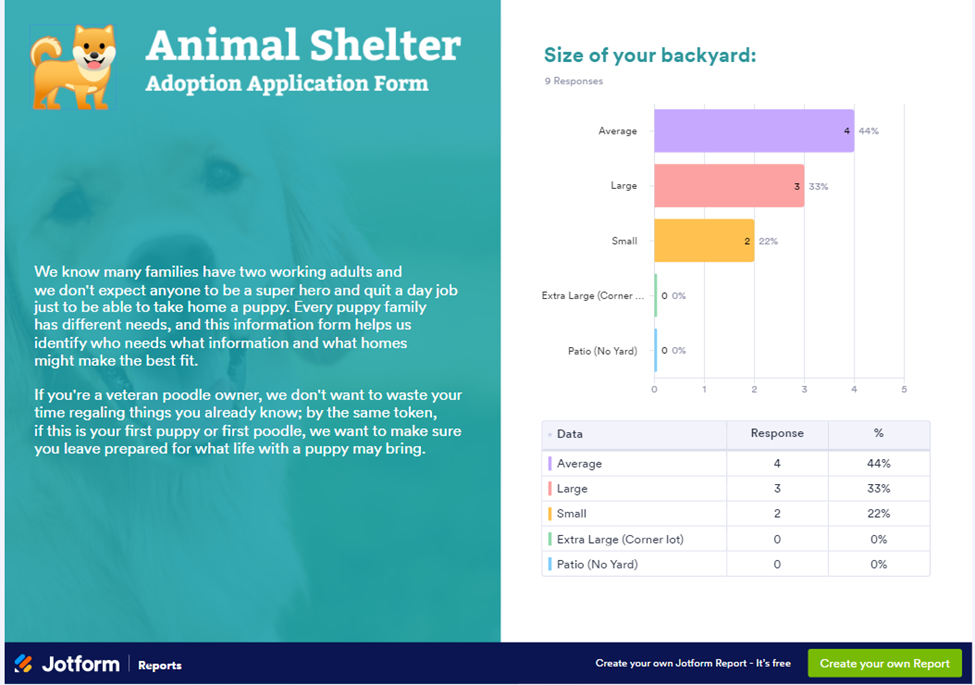
Essentially, researchers use survey reports to present data they’ve collected from a survey. Survey reporting is important because it gives the surveyor and other stakeholders a way to view and understand the data that a survey collected. It can also help them quickly glean insights from the survey data. It’s important for survey reports to present data in a fully objective manner so the audience can make decisions based on facts. For example, say you’ve conducted a survey about which software your audience prefers, and the results showed that most people preferred software A over software B or C. The report should state that the majority of respondents preferred software A, but it shouldn’t include any subjective comments, such as asserting that people prefer software A because software B and C aren’t good software products. In addition to text, you can present the data in a survey report visually, such as in a chart or graph, to better showcase the information you’ve collected to the audience. Many people learn visually, and these elements can provide additional context to help them draw conclusions.
Let’s look at some examples of specific surveys and how their results could be presented visually.
The purpose of this survey was to get people’s opinions on company meetings. To add context and perspective to the answers, respondents also provided relevant data about themselves, including their role within the organization and their industry. The survey included a total of 715 respondents.
The survey posed five questions:
The survey creators aggregated responses to each question and then displayed them using a visual to make communicating the data easy. We showcase each visual below.
As part of the survey report, the survey creators presented the answers to the role and industry questions in the form of a bar chart. This allowed them to clearly delineate and identify the size of the various roles and industries. The chart shows that most respondents were either at the executive or associate level. The second chart shows a mixed bag of industries.

For the meeting time and format questions, respondents had just a few options to choose from, and the survey creators were interested in seeing the share of people that selected each option. A pie chart is the perfect visual to showcase how respondents answered.
The first pie chart shows that most meetings were on the shorter end — between zero and three hours long. The second chart shows that meetings were overwhelmingly in person.

The survey creators presented the last question, which asked about meeting effectiveness, in a table summary format. The table summary places the most frequently selected response front and center. It also lists all responses in order of frequency.

This survey report example was more fun than practical, but it offers some additional visuals to consider for your own survey report. In this fictitious example, imagine that the survey creators are owners of a lemonade stand who wanted to find out what customers thought about their product.
The survey asked respondents two questions:
Check out the visuals used for each question’s responses below.
This visual differs from traditional charts and graphs by adding a little personality. Instead of lines, bars, or pies, you present results using a collection of emoji-like faces. You get a smiley, neutral, or sad face depending on how positive (or negative) the responses are. Smiles tend to be universal, so it’s immediately evident how respondents rated your business when you view the image. (In this case, most people liked the lemonade!)

Both survey report examples employed pie charts, which isn’t surprising given how effective this simple visual is at displaying certain data sets. This survey report used a pie chart for the last question about recommending the lemonade. Interestingly enough, despite most respondents enjoying the lemonade, only half said they’d recommend it to a friend.

Straw polls are important in the political sphere because they help politicians and their teams understand who people will be voting for in an upcoming election. In this hypothetical example, the straw poll included these questions:
Similar to a pie chart, a donut chart is useful in visualizing percentages of a whole. However, unlike a pie chart — which displays just one series of data — a donut chart is actually useful for visualizing multiple series of data, with each series being a separate ring on the chart.
In this example, we see one series of data of candidate preferences. If we were surveying different geographies, we could add rings and the corresponding results for each geographical location.

Sometimes, one visual representation of the same data set isn’t enough. Displaying the same data in two or more ways can help the stakeholders make more sense of the information and gain the insights they need to make better decisions.
In this example below, we can see a pie chart in addition to a table that contains the same data. The pie chart may be more helpful to visual learners, while the table may be more helpful for those who learn better from seeing text and numbers.

This fictitious report from an animal shelter summarizes the information gathered from their adoption application form. It not only shares useful information, but also contains the animal shelter’s branding and uses storytelling elements.
Some of the questions in this report include
Some types of survey results reports require text in addition to visuals and numbers. In this example, the animal shelter offers context for a particular question and explains why it’s important. It also includes a bar graph and a table.

A successful survey results report includes vital information that engages the stakeholders and provides them with the information they want to know. Here’s how to do it:
To ensure you successfully communicate the findings from your survey report in a presentation, it’s best to start with your audience. Who are you presenting the report to? Is it an executive in the C-suite or kids in your class? Is it someone who’s already familiar with the survey or someone who has no background or context for it? Your audience should inform how you deliver your presentation.
For example, the more your audience already knows about the survey and the reason for it, the less background information you have to provide in the report. The less they know, the more context you have to offer.
Similarly, consider how much time your audience has to spend on the report. Are they just looking for a five-minute overview, or do they want a deep dive into the data?
You’ll also want to consider the audience’s role in the survey process. Are they required to help you decide next steps, for example, or are you just showing them your findings to back up the decision you’ve already made? Are you teaching them something from the results, or are they there to help you learn something from the findings? This will also have an affect on the amount of information you provide in the report and how you’ll present it.
When it comes to the presentation itself, it’s important to share it in multiple ways so you can meet the needs of your audience. For example, offer a print or digital copy of the report, talk through it in a meeting or call, and project the report on a screen as you talk through it. This way, you’ll provide the audience with multiple ways to digest the information you’re sharing.
Did the visuals from these survey report examples inspire you? You can start building your own survey reports today using Jotform Report Builder. With Report Builder, you can automatically create real-time reports and presentations from submissions to your Jotform survey. Just drag and drop to customize the design to fit your needs.